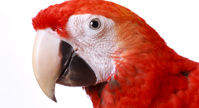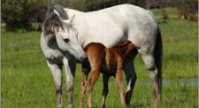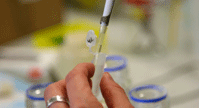Equine Coat Color Testing
Base Color
Every horse has a base color, which can be black, bay, or red. This is controlled by the Extension (Red/Black Factor) and Agouti genes. The Extension gene controls the production of black or red pigment throughout the coat. The allele for black color (E) is dominant over the red allele (e), so a horse only needs one copy of the black allele to appear black-based.
The Agouti gene can then modify black pigment by pushing it the the points of the horse, creating a bay. The Agouti gene is dominant, so a black pigmented horse only needs one copy of the Agouti gene (A) to appear bay. Agouti does not have any effect on red pigment.
There may be some variation in the intensity of the base colors, for example, dark bays compared to light bays or liver chestnuts to sorrels. This could be caused by a variation in the expression of the genes or interaction of other genetic factors.
| Horse Base Coat | Red/Black Factor | Agouti |
|---|---|---|
| Solid Black | EE or Ee | aa |
| Bay or Brown | EE or Ee | AA or Aa |
| Red (Chestnut/Sorrel) | ee | AA, Aa, or aa |
Dilutions
The rest of the color genes act as modifiers on the base coat of the horse. There are several genes that dilute the color of the horse, including Cream, Pearl, Champagne, Silver, and Dun. While these genes all function to dilute pigment, they are not all expressed in the same manner. The Dun and Champagne genes are dominant, as is Silver, although Silver does not affected red pigment. The Cream gene is incompletely dominant, meaning you will see different effects with the number of Cream genes present, and the Pearl Gene is recessive. The Cream and Pearl genes do have additive effects, so color testing can be an important tool to determine the correct color of a horse and what it may be able to pass on. The Grey gene causes a horse to 'grey out' over time, and is dominant, although homozygous horses tend to grey out faster. It is thought that there are other color modifiers, such as Flaxen or Sooty, but the genetic basis to these colors have not yet been determined.
| Dilution Gene | Mode of Inheritance | Champagne Dilution | Dominant |
|---|---|
| Cream Dilution | Incomplete Dominant |
| Dun Dilution | Dominant |
| Pearl Dilution | Recessive *Additive Effect with Cream |
| Silver Dilution | Dominant *No effect on red pigment |
Patterns and depigmentation
The pattern genes also modify the color of the horse by deleting color. These genes include Frame Overo, Splashed White Overo, Sabino1, Tobiano, Dominant White, and Leopard Print or Appaloosa. The term 'overo' is a general term used to describe a patterned horse. Thus, a horse that is termed a "Tovero" is a combination of a Tobiano and another overo gene, whereas an 'overo' horse could mean any of the patterned genes, such as Frame or Sabino.
| Pattern Gene | Mode of Inheritance |
|---|---|
| Appaloosa Coat Pattern (LP) | Incomplete Dominant |
| Pattern-1 (PATN1) | Dominant |
| Dominant White | Dominant *Can be Homozygous Lethal |
| Frame Overo (LWO) | Incomplete Dominant *Homozygous Lethal |
| Splash 1 | Incomplete Dominant |
| Splash 2 | Incomplete Dominant *Homozygous Lethal |
| Splash 3 | Incomplete Dominant *Homozygous Lethal |
| Grey | Dominant |
| Sabino 1 | Incomplete Dominant |
| Splashed White Overo | Dominant *2 and 3 are Homozygous Lethal |
| Tobiano | Dominant |
Coat Color Calculator
Visit our Coat Color Calculator page to determine potential coat colors based on parents' coat patterns and colors.
Submit a Sample for Testing:
To submit a sample for testing please click on ORDER and download a sample submission form. Then follow the sample collection and submission instructions.










